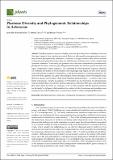Por favor, use este identificador para citar o enlazar a este item:
http://hdl.handle.net/10261/256444COMPARTIR / EXPORTAR:
 SHARE SHARE
 CORE
BASE CORE
BASE
|
|
| Visualizar otros formatos: MARC | Dublin Core | RDF | ORE | MODS | METS | DIDL | DATACITE | |

| Título: | Plastome Diversity and Phylogenomic Relationships in Asteraceae |
Autor: | Pascual-Díaz, Joan Pere CSIC ORCID ; Garcia, Sònia CSIC ORCID ; Vitales, Daniel CSIC ORCID | Palabras clave: | Chloroplast genome Compositae Phylogenetic incongruence Plastid DNA Senecioneae |
Fecha de publicación: | 8-dic-2021 | Editor: | Multidisciplinary Digital Publishing Institute | Citación: | Plants 10,12:2699 (2021) | Resumen: | Plastid genomes are in general highly conserved given their slow evolutionary rate, and thus large changes in their structure are unusual. However, when specific rearrangements are present, they are often phylogenetically informative. Asteraceae is a highly diverse family whose evolution is long driven by polyploidy (up to 48x) and hybridization, both processes usually complicating systematic inferences. In this study, we generated one of the most comprehensive plastome-based phylogenies of family Asteraceae, providing information about the structure, genetic diversity and repeat composition of these sequences. By comparing the whole-plastome sequences obtained, we confirmed the double inversion located in the long single-copy region, for most of the species analyzed (with the exception of basal tribes), a well-known feature for Asteraceae plastomes. We also showed that genome size, gene order and gene content are highly conserved along the family. However, species representative of the basal subfamily Barnadesioideae¿as well as in the sister family Calyceraceae¿lack the pseudogene rps19 located in one inverted repeat. The phylogenomic analysis conducted here, based on 63 protein-coding genes, 30 transfer RNA genes and 21 ribosomal RNA genes from 36 species of Asteraceae, were overall consistent with the general consensus for the family¿s phylogeny while resolving the position of tribe Senecioneae and revealing some incongruences at tribe level between reconstructions based on nuclear and plastid DNA data. | Versión del editor: | https://doi.org/10.3390/plants10122699 | URI: | http://hdl.handle.net/10261/256444 | DOI: | https://doi.org/10.3390/plants10122699 | Identificadores: | doi: https://doi.org/10.3390/plants10122699 e-issn: 2223-7747 |
| Aparece en las colecciones: | (IBB) Artículos |
Ficheros en este ítem:
| Fichero | Descripción | Tamaño | Formato | |
|---|---|---|---|---|
| plants-10-02699.pdf | 3,9 MB | Adobe PDF |  Visualizar/Abrir |
CORE Recommender
Page view(s)
177
checked on 24-abr-2024
Download(s)
113
checked on 24-abr-2024
Google ScholarTM
Check
Altmetric
Altmetric
Este item está licenciado bajo una Licencia Creative Commons

